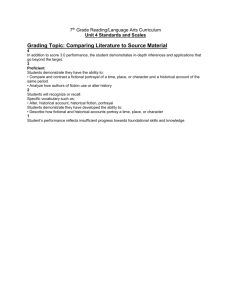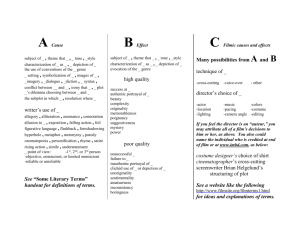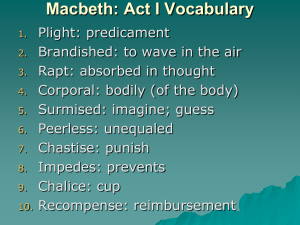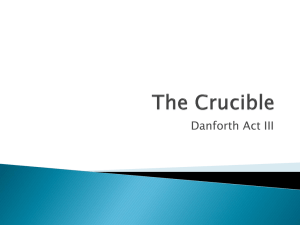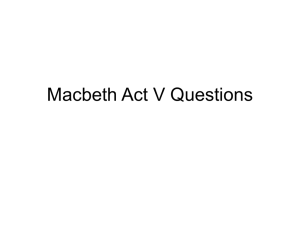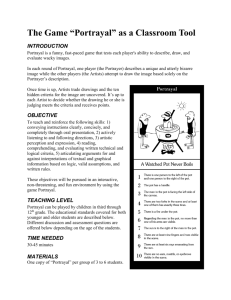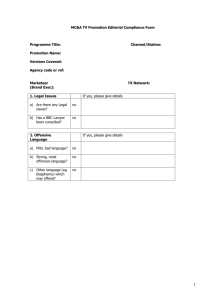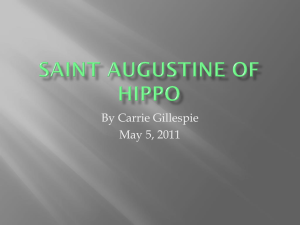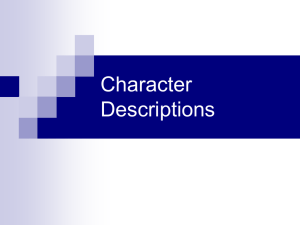Margret Atwood & Suu Kyi
advertisement
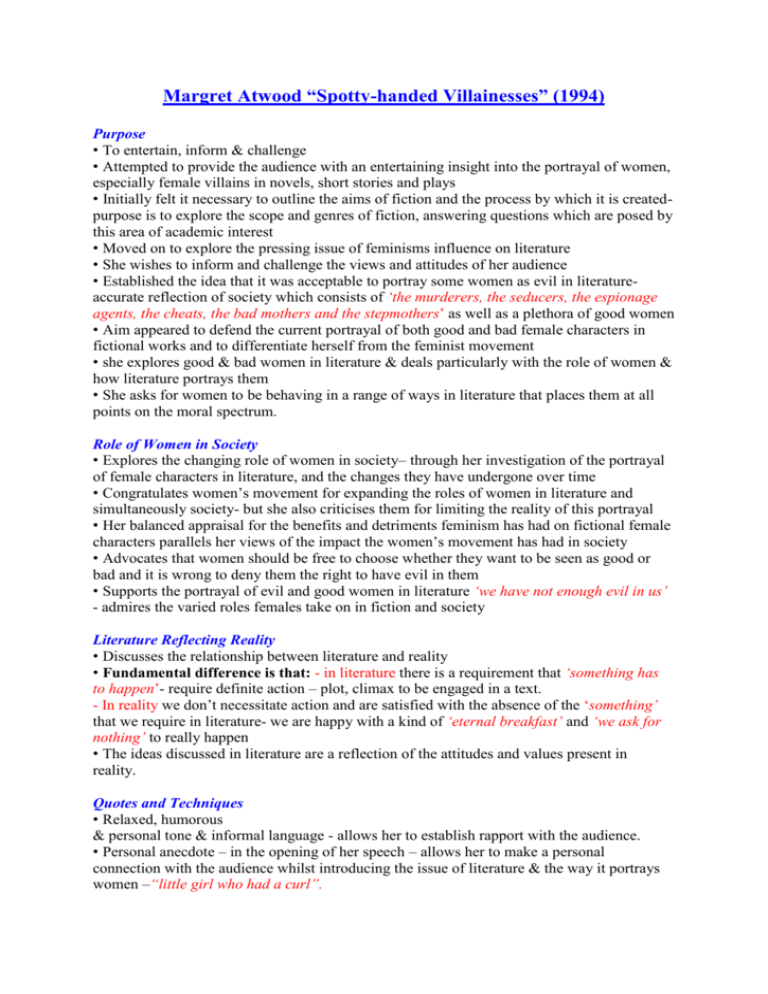
Margret Atwood “Spotty-handed Villainesses” (1994) Purpose • To entertain, inform & challenge • Attempted to provide the audience with an entertaining insight into the portrayal of women, especially female villains in novels, short stories and plays • Initially felt it necessary to outline the aims of fiction and the process by which it is createdpurpose is to explore the scope and genres of fiction, answering questions which are posed by this area of academic interest • Moved on to explore the pressing issue of feminisms influence on literature • She wishes to inform and challenge the views and attitudes of her audience • Established the idea that it was acceptable to portray some women as evil in literatureaccurate reflection of society which consists of ‘the murderers, the seducers, the espionage agents, the cheats, the bad mothers and the stepmothers’ as well as a plethora of good women • Aim appeared to defend the current portrayal of both good and bad female characters in fictional works and to differentiate herself from the feminist movement • she explores good & bad women in literature & deals particularly with the role of women & how literature portrays them • She asks for women to be behaving in a range of ways in literature that places them at all points on the moral spectrum. Role of Women in Society • Explores the changing role of women in society– through her investigation of the portrayal of female characters in literature, and the changes they have undergone over time • Congratulates women’s movement for expanding the roles of women in literature and simultaneously society- but she also criticises them for limiting the reality of this portrayal • Her balanced appraisal for the benefits and detriments feminism has had on fictional female characters parallels her views of the impact the women’s movement has had in society • Advocates that women should be free to choose whether they want to be seen as good or bad and it is wrong to deny them the right to have evil in them • Supports the portrayal of evil and good women in literature ‘we have not enough evil in us’ - admires the varied roles females take on in fiction and society Literature Reflecting Reality • Discusses the relationship between literature and reality • Fundamental difference is that: - in literature there is a requirement that ‘something has to happen’- require definite action – plot, climax to be engaged in a text. - In reality we don’t necessitate action and are satisfied with the absence of the ‘something’ that we require in literature- we are happy with a kind of ‘eternal breakfast’ and ‘we ask for nothing’ to really happen • The ideas discussed in literature are a reflection of the attitudes and values present in reality. Quotes and Techniques • Relaxed, humorous & personal tone & informal language - allows her to establish rapport with the audience. • Personal anecdote – in the opening of her speech – allows her to make a personal connection with the audience whilst introducing the issue of literature & the way it portrays women –“little girl who had a curl”. • Colloquialisms – make her speech more accessible to the audience & the humour of them is engaging – “flogging a few dead horses”. Defends herself from the feminist stereotype by using the colloquial term ‘sex bomb’, feminists would not use this term. • Question & answer technique – “what is a novel?” & then she explains how it should be constructed. • Humourous metaphor & religious allusion– compares the job of a novelist to God’s task of creating the world, “one detail at a time” – emphasises the difficulty of writing & appeals to the religious beliefs of the audience. • Historical & literary references – allows her to validate her points & exploration about the role of women & how they are portrayed in literature (good & bad) & the responder can easily identify with them – Cinderella, Sleeping Beauty, Snow White, Shakespeare – Lady Macbeth. Makes the point that female authors should not restricted to using only good female characters. • Criticism of the women’s movement through a paradox to illustrate the divide which has been created between “women who wore high-heels and make-up” and “those in overalls”. • Quote from a notable historical figure – Dame Rebecca West – “we have not enough evil in us”. • Repetition – “novels are not” – emphasises her point. • Spotty handed villainess- allusion to Lady Macbeth – portrayed as flawed character – killed King Duncan with her husband Macbeth. Illustrating the idea that women can be bad too. • Shares her vision of how women should be viewed in society and literature Reference: Downloaded from boredofstudies.org 2008 Aung San Suu Kyi ‘Keynote Address to the Beijing World Conference on Women’ (1995) Purpose To present an analytical overview of the global forces affecting the quality of life of the human community and the challenges these pose for everyone and for women in particular To liberate women around the world and help them to realise and fulfil their role in society as peacekeepers Global forces mentioned included approaches to governance, such as questions of citizenship and political participation, as well as looking at obstacles to peace and human security such as militarization, violence and poverty Addressed these issues which took on global significance and also targeted her domestic audience o Did this by criticising the government’s failure to end their oppressive tactics used to maintain power o Criticised the government for denying that ‘women too can play a part in bringing the necessary change and progress to their society’ Speech carried with it the international purpose of campaigning for the liberation of women, motivating women to achieve their full potential and unifying females throughout the world in the fight for equality Attempted to use speech to inspire hope that change is possible through non violent protest within Burma Role of Women in Society Focus on the role of women in society, government and politics to ‘struggle for justice and peace’ in the world She strongly believes that this role should be centred on their traditional, biological qualities and their dedication to the ‘nurturing, protecting and caring for the young and old’ These qualities ‘imposed on’ women enable them to play an important role in inciting political and social change, provoking progress and helping to ‘dissipate the darkness of intolerance… and suffering’ Women play a large role in helping to achieve ‘a peaceful life for all’ within the global community Traditionally given the ‘responsibility of teaching children values that will guide them throughout their lives’ women have a privileged role as teachers and educators of tomorrow’s generation Women are also good communicators allowing them to solve ‘situations of conflict’ and deliver peace by non-violent means Women, as ‘intelligent human beings’ who have performed highly ‘in our educational system and the management of commercial enterprises ’can ‘contribute to the betterment of society’ by playing a greater role in business and in government In order for world to truly appreciate role of women they need to be given a political platform and a role in government to ‘participate fully In the decisions and processes that shape their lives’ Quotes & Techniques Positive emotive words- wonderful, splendid, greatest 1. Helps to congratulate the women who have organised forum and begins on a positive tone Uses strong emotive language whenever discussing the role of women in society 1. strong and principled 2. ‘emancipated..empowered’ women who with their ‘wisdom and experience’ should ‘struggle for justice and peace’ o Positive words are used to illustrate the vital contribution women can make to the world Reduces the contribution of men using negative, emotive language 1. ‘patronising behaviour or exploitation’ 2. ‘patriarchal domination and degradation’ Uses sarcasm and irony when discussing ‘war toys of grown men’ 1. reduces men to little boys whose childish games have fatal consequences for women and children Discrepancy between contribution of males and females is highlighted by a contrast of positive and negative connotations 1. ‘compassion and self-sacrifice, their courage and perseverance’ juxtaposed with ‘the darkness of intolerance and hate, suffering and despair’ illustrates how important women are by presenting a bleak image of a world without them Religious allusions to appeal to the religious beliefs of her audience and to justify her opinions as being approved by god References to Buddhism and philosophies is effective in presenting ‘mutual understanding and peace’ as a religious and ‘spiritual aspiration’ we must strive towards Cultural references using her own background to present an understandable intelligent and humorous analogy 1. ‘Burmese proverb- the dawn rises only when the rooster crows’ o metaphoric light women bring to the world to ‘relieve the darkness of the night By appealing to the audiences cultural and religious values she illustrates how women ‘too can play a part in bringing change’ Broadens her opinions and ‘own experience... in Burma´ to an international platform Global reference to the International Year of Tolerance Direct quote from UN who have recognised that ‘tolerance, human rights, democracy and peace are closely related’ Provides political statistics to add credibility Similes 1. ‘tender as mothers nursing their newly born’ 2. ‘brave as lionesses defending their young’ Describing wife’s dedication to husband By evoking poetic and maternal images she illustrates how women should use their biological tendency to nurture loved ones to ‘work for the good of their country’ and create peace Universal images similar to the clichés she uses- ‘live and let live’ ‘the other side of the coin’ Speech retains an inherent poetic quality- clichéd metaphor- ‘women to mould their own destiny’ Idealises the empowerment of women as being a timeless aim Rhetorical questions- ‘But is this really a weakness? Could it not be in fact a strength?’ ‘How much more could they not achieve?’ –asks for the obvious truths Starts many sentences with conjunctions- ‘But there’, ‘And in’, ‘And the’.- creates a flow of ideas and dramatic pause

